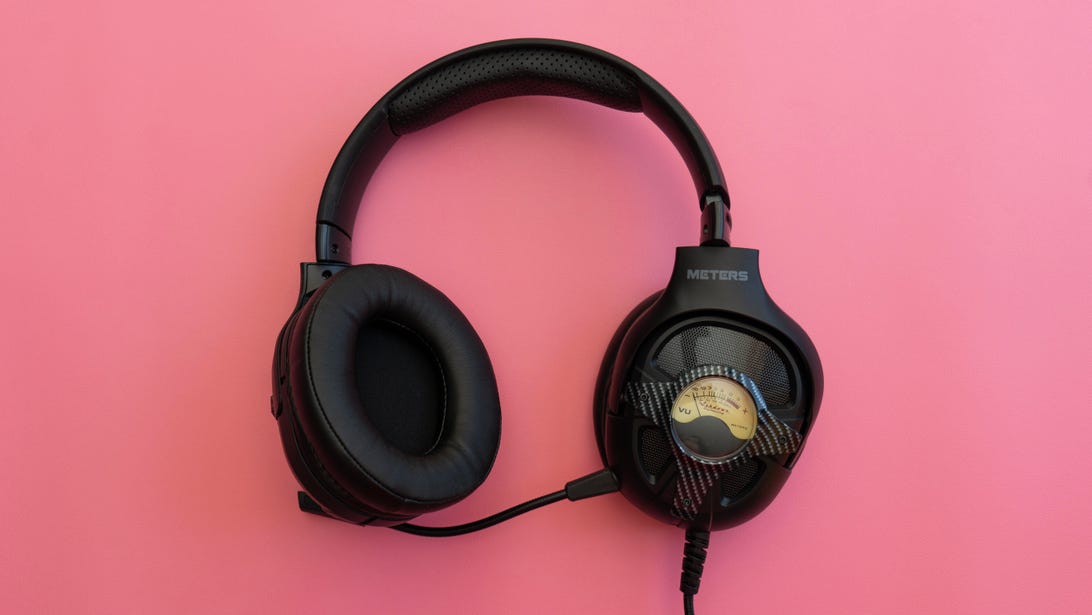Lori Grunin/CNET
Meters’ $130 (£99) Level Up gaming headset doesn’t add up to as much as I’d like when applying objective criteria, but its retro-ish style with on-earcup illuminated VU meters, full-bodied stereo and 7.1 virtual surround sound for music and gaming and its comfortable weight have somehow managed to carve out a spot in my heart.
The headset is the company’s first gaming product and only its second consumer-focused model. It follows Meters’ first headset, the general-purpose Bluetooth OV-1-B line, which is at most a couple of years old by now. But as a part of veteran professional amp manufacturer Ashdown Engineering, the company itself is certainly no newcomer to audio.
You can buy the Level Ups with the VU meter mounted in black and gray (Carbon), red or silver (though I’m more partial to the visual style of the OV-1-B Connect, which seem to achieve both greater elegance and flash).
The headset bears the company’s signature on-ear VU meters, which are more for show than tell, at least in this case. (And TIL that VU stands for volume unit.) They reflect the relative loudness of the audio, but at a volume where they register visible fluctuations you definitely don’t want them close to your ears. You can change the color of the illumination or have it cycle automatically through them because gaming.
This is one of the looser headsets I’ve tested — too loose, at least on my medium head (approximately 23 inches around my ears). On the upside, the extra room makes it fit well with glasses, and it’s one of the only headsets I’ve tried that feels comfortable draped around my neck. At 320 grams (11.3 ounces), the same as a competitor like the HyperX Cloud 2, it’s reasonably lightweight with similar leatherette covered foam cups.

The earcups swivel to lie flat when the headset’s lying around your neck, but unlike many others it’s not strangle-me tight.
Lori Grunin/CNET
The toggle button that controls the colors is on an inline controller along with the mic mute, volume and 3.5mm analog jack. Because a lot of the advanced and gimmicky adjustments are controlled through a free driver for Windows, you only get them on a PC via USB. This includes things such as the 7.1 virtual surround speaker positioning, equalizer settings, environment effects, mic monitoring, mic noise reduction and mic effects called Magic Voice, which plays with the frequencies to kinda-sorta make you sound like the opposite sex, a monster or a cartoon.
The 7.1 Virtual Speaker Shifter in the driver lets you control the angle and distance of all the virtual channels, but it also boasts one unusual feature: You can make it rotate all the speaker positions simultaneously until it sounds “right.” Even better, it works with whatever sound is currently playing, not just with canned sounds like Razer‘s THX utility, which lets you optimize for different types of games or movies. Plus, you can control the volume of individual channels. You can’t save them as custom presets, though.
The analog connection into the inline controller lets you use the headset with other devices, specifically consoles and phones. You can still get 7.1-channel sound if a game specifically supports it, but you don’t have any of the same control over speaker positioning or individual channel volumes that you do with the Windows utility (it also doesn’t support THX or Dolby Atmos). Still, audio-optimized games on Xbox like Ori and the Will of the Wisps sound terrific.
Also see: The best Xbox gaming headset for 2021
Voice from the condenser mic sounds very clear, if a bit bright, but the mic pickup is a bit too broad and the Xear software noise reduction is meh. My roommate, yelling on her Zoom call in another room, and my cat, Iris the Destroyer, yowling behind me for her lap time, both rang clearly. It also lacks some chat features you’d expect for the money, notably game/chat balance either in software or on the inline control.
The design for analog use is quite awkward, as well. Since you plug the cable into the fixed inline control, which sits in the middle of the USB cable, you’ve basically got about six feet of the 7.2-foot (2.2 meter) USB cable hanging loose when you’re connected to, say, an Xbox controller via the analog jack. I prefer Razer’s analog-cable-into-a-USB-dongle and HyperX’s swapping-all-cables-into-the-inline-controller approaches to multiplatform support. In fact, I’m not fond of Level Up’s cabling in general. It’s braided, which is good, but also too thick and stiff, so it annoyingly tangles and kinks.
Meters Level Up will never displace Razer’s, HyperX’s, Logitech‘s or most other top headsets on best-seller lists of gaming gear; it’s more of a niche player. But if you’re looking for something a little atypical looking for PC gaming — or have a larger than average head — your ears should be as happy as your eyes.

Be the first to comment